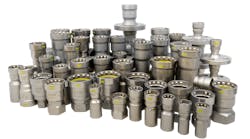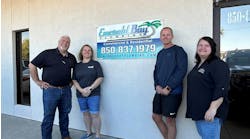Washington — The U.S. Environmental Protection Agency has begun drafting performance specifications for high-efficiency urinals under its WaterSense program.
The specifications, once final, will establish performance criteria to identify products that meet criteria for both water efficiency and performance, according to the EPA.
The agency said it intends to develop separate specifications for flushing urinals and waterless urinals because of differences in design, components and how they function.
According to the EPA, it is considering a maximum allowable flush volume of 0.5-gal. per flush for flushing urinals. The EPA noted that the California Urban Water Conservation Council and a select group of its water provider members developed a similar standard for HEUs in 2004 that is now a widely recognized and accepted standard in the plumbing industry.
Rob Zimmerman, Kohler's senior staff engineer for water conservation initiatives, applauded WaterSense for taking a common sense approach to defining HEUs.
“Rather than try and start from scratch, WaterSense has done what I think is the right thing and taken those existing, informal specifications and tried to formalize them,” he said.
Also under consideration by WaterSense is a requirement that flushometer valves be non-adjustable as to flush volume as well as tamper-proof. The valves also would not be able to contain interchangeable parts that would allow an increase in flush volume once installed and would need to have a non-hold down/automatic shutoff feature.
The WaterSense program also will address how to test and label separate components of flushing HEUs, perhaps by allowing for the independent testing and labeling of each urinal fixture and flushometer valve. According to the EPA, this approach enables consumers to easily identify labeled HEUs by identifying and matching labeled components, rather than verifying the individual component model numbers for compatibility.
While the EPA plans to move forward with a specification for high-efficiency flush urinals, it indicated it will delay developing a standard for waterless urinals to further study and resolve drain line issues. The agency's primary concern is the impact that significantly reduced water flows from HEUs might have on the buildup of urine solids in the drain line, leading to restricted flow or clogging.
Klaus Reichardt, founder and managing partner of Waterless Co., said issues such as the layout of drain lines and the chemical reaction between water and waste always will result in some level of clogging.
“No matter what kind of standards you set, you will have clogs,” he said. “Clogs have been a way of life for the last 100 years ever since we've had flush toilets and urinals. You always want to minimize that, absolutely, but you can't get away from anticipating clogs.”
Zimmerman said waterless urinals require proper maintenance in order for them to perform correctly.
“What happens is that waterless urinals have been installed, they have not been properly maintained and there are issues, particularly with either plugging or buildup in the drain line to where people are very dissatisfied with them,” he said.
Regardless of any unresolved issues, the consensus among those in the industry is that WaterSense is moving in the right direction when it comes to developing specifications for HEUs and other plumbing products.
Shawn Martin, technical director of the Plumbing Manufacturers Institute, pointed to the program's emphasis on ensuring that products not only conserve water, but work effectively as well.
“WaterSense has had the foresight to work collaboratively with industry experts to ensure that products bearing the WaterSense logo work well and gain the trust of the consumer in the marketplace,” he said.
Dave Viola, director of special services for the International Association of Plumbing and Mechanical Officials, said he is seeing signs that WaterSense is having animpact.
“Obviously, WaterSense has a long way to go, but early indications are that the high-efficiency toilet and lavatory faucet specifications are making an impact. I believe the WaterSense Program will be very successful, as it is showing up in green building standards, purchase specifications and in manufacturer and supplier marketing campaigns.”
However, Zimmerman noted one of the program's limitations in becoming as recognizable as the EPA's Energy Star program, which promotes energy efficiency.
“I think a concern that we have is the lack of sufficient funding from the federal government to support the program,” Zimmerman said. “What WaterSense is really trying to do is to build a brand like Energy Star that people recognize and look for when they're shopping for a product that consumes water. On a budget that's under $5 million, it's really hard to do that.”
The EPA is encouraging interested parties to submit data and comments to WaterSense. Additional information is available at [email protected].

